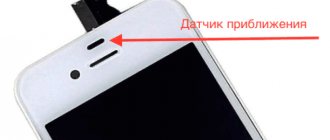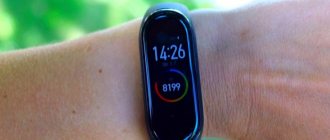The operation of the proximity sensor is the Achilles heel of smartphones. High-tech, fast and inexpensive, they nevertheless have several significant drawbacks, one of which is the operation of the proximity sensor. Designed to turn off the screen during a call, it does not always work correctly. The problem is systemic in nature, is fixed on various models of Xiaomi phones, and is very annoying to the owners of such gadgets. How can you disable the proximity sensor on Xiaomi smartphones, and what methods exist for this? We'll tell you in our material.
What is a Xiaomi proximity sensor and what is it responsible for?
The proximity sensor or, as it is also called, the light sensor is responsible for proximity, or rather for turning off the screen during a telephone conversation and for adjusting the brightness level.
Sometimes the question comes: “Where is the proximity sensor?” In fact, the word “sensor” is rather conditional, denoting the presence of a special sensor in the design of the device next to the front camera and earpiece.
Disruption of this function has many inconveniences. For example, during a conversation you can accidentally press unwanted buttons or drop the call altogether. If the proximity sensor does not work, the phone, while in your pocket, may involuntarily perform any actions or call someone, guided by touching the screen to clothing.
Use an external application
The third-party app “Proximity Sensor Reset Repair” can also help restore the proximity sensor on Xiaomi. The functionality of this application allows you to overwrite the sensor value, thereby correcting any software anomalies. After installing the application, you need to leave it running in the background, allowing it to fix software errors that occur.
Causes of problems
Speaking about the occurrence of a sensor problem, we can identify some cases that may lead to problems. The main part relates to the settings inside the phone.
Causes of problems:
- The sensor function is disabled;
- Activating unnecessary options;
- Incorrect film or protective glass. Operation may be disrupted if the glass or film does not have a special hole for the speaker or front camera. In such a situation, you just need to change the protective material.
- Incorrect operation of the device itself. Only in this case will it be necessary to calibrate the sensor
Now let's look at each case separately.
Removing physical obstacles
If, after disabling all kinds of interfering functions, the lighting sensor continues to malfunction, it is possible that the problem is due to physical obstacles. There are several influential factors that will lead to problems with the sensor:
- a film or glass covering the entire area of the front panel of the device interferes with the correct operation of the sensor. It happens that Chinese stores sell films for devices without corresponding cutouts for the camera and sensors, which is why the sensors “do not understand” that there is no lighting at the moment and you need to turn off the display during a call. To do this, you should re-glue the film or make a cutout yourself in the location of the sensor;
- Contamination plays an important role in this context, since if the user wears the device without a case, the holes in the film or glass become clogged with dust and dirt. It is worth cleaning the sensor area;
- If the seal of the case is broken, contamination can also occur under the display glass. In this case, you can try to clean the inside of the glass yourself if you have the appropriate skills, or take the smartphone to a service center, which is highly recommended;
- A broken device screen is another reason why the sensor does not work.
Enable the light sensor function:
- Go to the Phone application and open the menu located at the top right (three dots);
Xiaomi Proximity Sensor
- Click on the “Settings” field, then you will be taken to the call settings, where you need to scroll down the page and find the “Incoming calls” section - go there;
- Find the “Proximity sensor” field and pay attention to its status;
- If the option is disabled, enable it;
Ready.
You can also adjust the operation of the sensor by disabling an unnecessary function - locking it in your pocket.
This may interfere with sensory processing.
What does the proximity sensor do?
This sensor is necessary to automatically turn off the screen during a telephone conversation. The sensor simply locks the screen when you hold the phone to your ear. Activates it back when you bring the phone a certain distance from your ear. In addition, all sound notifications during a phone conversation are transferred to the speaker. Only you, and not your interlocutor, hears the sound of messages in the speaker. The sensor is located at the top of the phone. Just in the place where the speaker is located, which needs to be applied to the ear.
Why did I pay attention to Xiaomi and Redmi phones? The fact is that it is the phones of these brands that suffer from this problem more than others. The sensor is not calibrated properly, so its response can be either good or chaotic.
Disabling the lock in your pocket:
- You'll need to get to the call menu again through the Phone app;
- There, in the “Incoming Calls” tab, there is the “Block in Pocket” option, which should be disabled;
Ready.
Please note that the Pocket Lock feature is not present on all Xiaomi models or is located in a different location. As a rule, these are old versions of smartphones. For example, on the Xiaomi Redmi 3, Xiaomi Redmi 4 and Xiaomi Redmi 5 models, the path to this option will be different.
How to turn off the screen when talking on Xiaomi?
In the “Incoming calls” settings on Xiaomi, find and select the “Proximity sensor” item under which it will be written (turn off the screen automatically when you bring the phone to your ear during a conversation) and turn it on.
Interesting materials:
When will pensions be indexed in 2022 Ukraine? When will the call center be available? When will it rain blood 2022? When will the 2022 meteor shower happen? When will there be a sequel to the movie Titmouse? When will there be a sequel to The Last Hero? When will there be a continuation of the series Cop Wars Kharkov? When will the Nevsky series continue? When will the rocket launch from Baikonur? When will the waxing moon be in the month of May?
Another way to prevent unwanted clicks on Xiaomi:
- Open “Settings” and scroll the page a little;
- Open the “Lock screen” section and activate the “Prevent accidental clicks” function;
Ready.
If none of the above methods for setting up the sensor helped you, move on to more labor-intensive operations.
Proximity Sensor Calibration
Calibration is a rather serious process that requires extreme care, since it is carried out through the engineering and main menus, that is, you will be dealing directly with the hardware.
First, let's check if the sensor is working:
- First you should call the engineering menu. This is done like this: in dialing a phone number (Phone application), enter the following combination: “*#*#6484#*#*”. After this, the following functionality appears on the screen:
Xiaomi proximity sensor - calibration
- Select “Single item Test”, then “Proximity Sensor”;
- A test will appear on the screen, during which when your finger is close to the screen (to the conversation speaker), there will be a corresponding inscription: “Close”, and at a distance - “Far”. If you saw this, then everything is fine. You can begin calibration. Otherwise, contact the service center.
4. Done.
Calibration is the same for all models: Xiaomi Mi 6, Xiaomi Redmi 3, Xiaomi Redmi Note 4, Xiaomi Redmi Note 5, Xiaomi Redmi 4x, etc.
Instructions:
- Turn off your phone;
- Now you need to call Main Menu. To do this, simultaneously hold down the volume up and power buttons. After the vibrating signal, release the power button, but continue to hold the volume key until the Xiaomi logo appears.
- If the opened functionality is in Chinese, translate it into English - click the “中文” button located to the right of the “download” button.
Xiaomi proximity sensor - instructions
- To open the engineering menu, press the topmost button;
- Next, click on “Proximity Sensor”.
- Place the gadget horizontally, placing it on something flat; it is also worth opening it completely, cleaning it, and freeing the sensor from bright light.
- To start calibration, press the “Calibration” key.
- Once the process is complete, “Successfully” will appear and you will then be prompted to test the sensor.
- Exit the menu and turn on the phone.
Ready.
As practice shows, work must be restored.
How to solve the problem with an incorrectly working proximity sensor
Often the problem can be corrected yourself without disabling the proximity sensor. Let's look at them in more detail.
Poor quality safety glass
When purchasing Chinese glass, users note deterioration in sensor performance. This is due to blocking the flow of light. The problem arises due to a violation of glass installation technology. Therefore, you need to remove the glass and check the operation of the gadget. If the defect has disappeared:
- Buy original glass instead of a cheap analogue.
- Contact a specialist to carefully apply the protection.
Deactivating the "In Pocket" function
An active function may impair sensor performance during a call. Therefore you need to disable it:
- From “Settings” go to “Screen lock”.
- Find “Pocket Mode” and set the slider to inactive.
Uncalibrated sensor
The ability to calibrate is not available on all models. Only in those with a MediaTek processor installed.
To calibrate the sensor you need:
- From “Settings” go to “About phone”.
- In “All Settings”, quickly click on “Kernel Version” up to 10 times until a message appears about enabling “Developer Mode”.
- Call up the menu by clicking on the three dots in the upper right corner.
- Find “Proximity sensor calibration” and click.
- Follow the calibrator's recommendations.
To check the operation of the sensor in developer mode:
- Find “Proximity sensor” in the menu.
- Close the top panel with the sensor and open it.
- Look at the change in the “Sensor Value” indicator.
- Repeat the last 2 steps several times.
Changing the parameter from 0 to 5 indicates the correct operation of the sensor.
Sensor calibration
Another rare but existing cause of sensor problems can be failures in the sensors. To fix this, you can also do a calibration, which is much simpler and faster than the previous one.
It is recommended to remove protective glass and films during calibration
Instructions:
- Call the engineering menu as described above;
- Find the "TouchPanel" function;
- The smartphone will offer instructions that you should follow by swiping your fingers across the screen;
- When the job is completed, you will receive a notification;
Xiaomi Proximity Sensor
- Turn on the device;
Ready.
For this, use special applications that are available in the Play Market: Display Calibration, TouchScreen Calibration, etc.
If calibration does not help
Have you done everything you need from the article, but the sensor still does not work? This means that the problem is in the hardware and you need to take the smartphone to a service center. Unfortunately, many service centers are not ready to repair Xiaomi smartphones due to the lack of spare parts. To do this, you should contact a Xiaomi certified center. Fortunately, they even accept devices by mail, repair them and send them back to the owner. But don’t rush to do this, since the problem can be fixed by simply updating your smartphone’s firmware.











